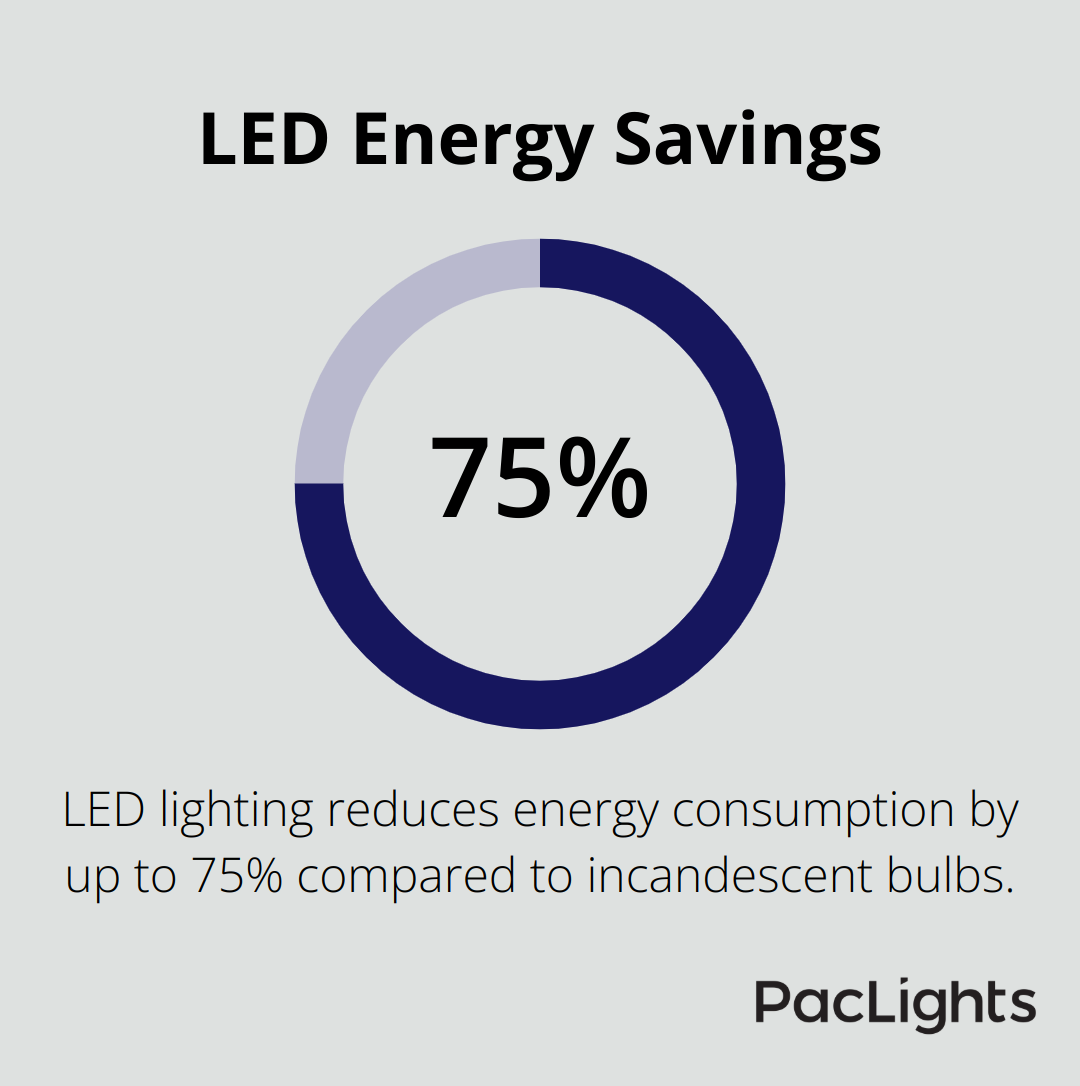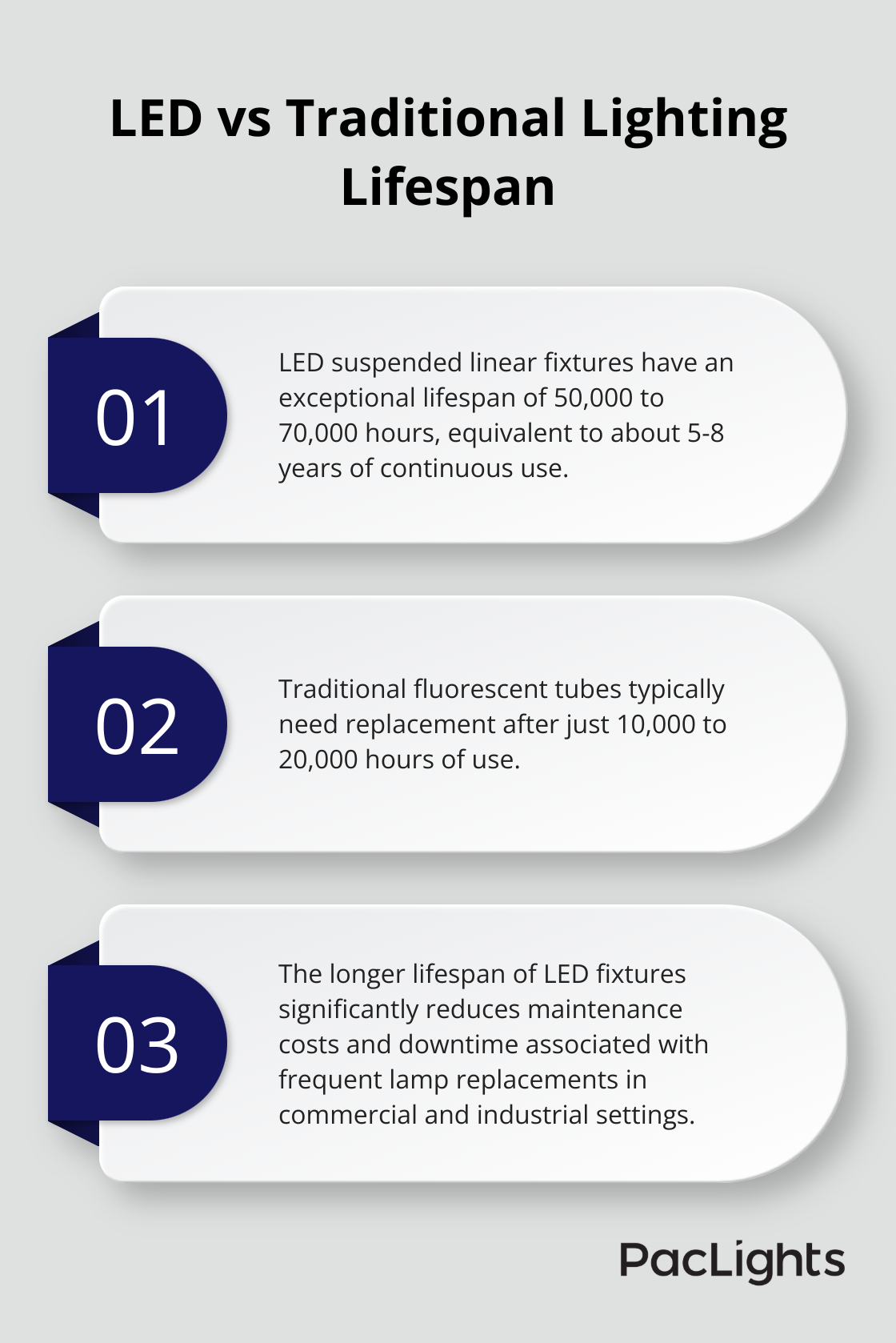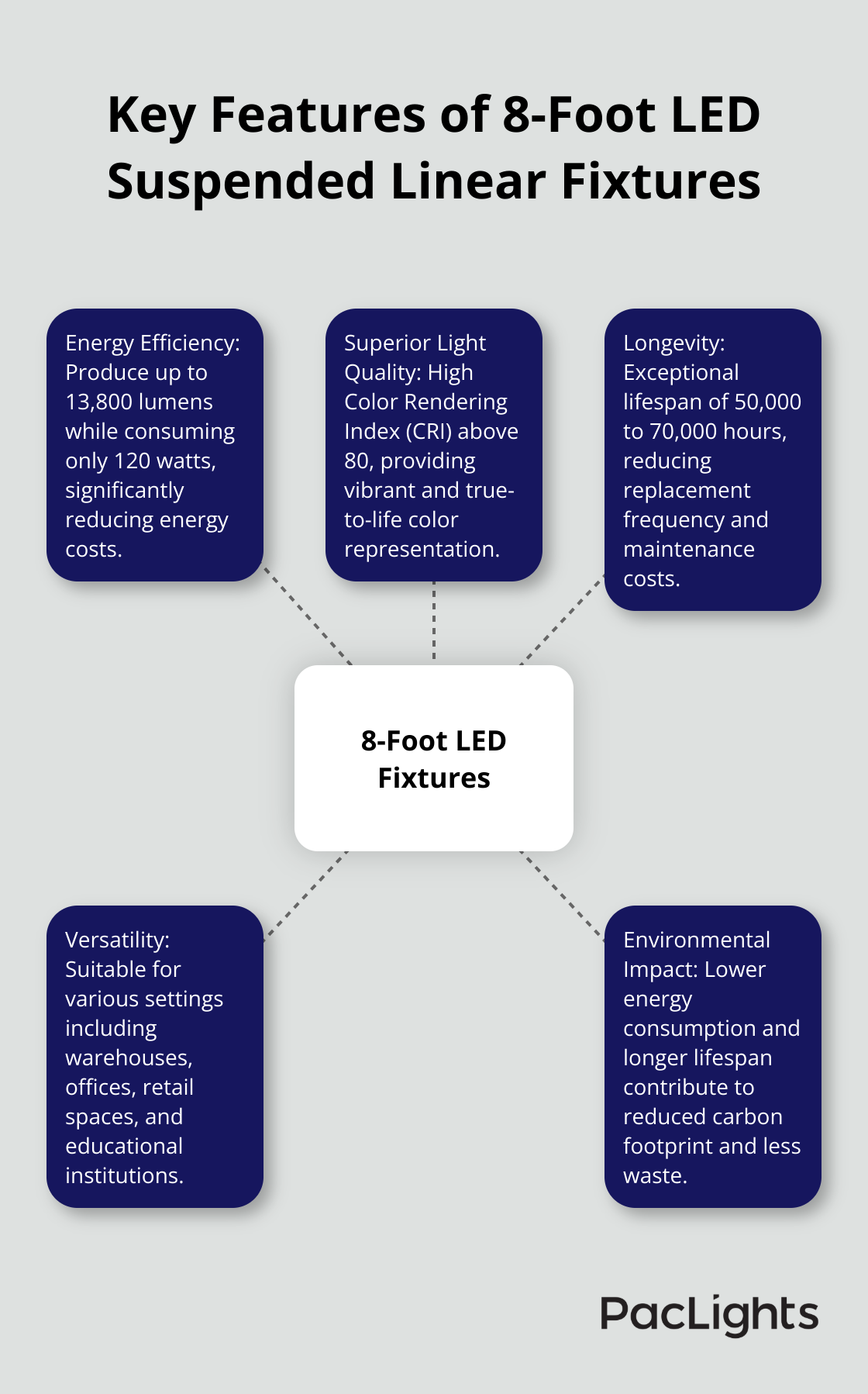Lighting solutions have come a long way, and at PacLights, we’re excited to explore the latest innovations.
The 8-foot LED suspended linear fixture is a game-changer in commercial and industrial lighting.
This powerful and efficient lighting option offers numerous benefits over traditional alternatives, from energy savings to improved light quality.
Let’s dive into what makes these fixtures stand out and how they can transform your space.
What Are 8-Foot LED Suspended Linear Fixtures?
Definition and Core Components
An 8-foot LED light typically refers to a linear light fixture that is 8 feet long, often used in settings where long stretches of illumination are needed. These fixtures typically consist of a sleek aluminum housing, high-quality LED chips, a driver, and a diffuser or lens to distribute light evenly.
Energy-Efficient Powerhouses
One of the standout features of these fixtures is their impressive energy efficiency. Some models can produce up to 13,800 lumens while consuming only 120 watts of power. This translates to significant energy savings compared to traditional lighting options. The U.S. Department of Energy reports that LED lighting can reduce energy consumption by up to 75% compared to incandescent bulbs.

Versatile Lighting Solutions
These fixtures offer remarkable versatility in terms of light output and color temperature. Many models come with selectable wattage options (ranging from 40W to 120W), allowing users to adjust the brightness to suit their specific needs. Color temperature options typically include 3000K, 3500K, 4000K, and 5000K, catering to various environments and preferences.
Long-Lasting Performance
Durability is a key benefit of 8-foot LED suspended linear fixtures. With an average lifespan of 50,000 to 70,000 hours, these fixtures significantly outlast traditional lighting options. This longevity not only reduces replacement costs but also minimizes maintenance disruptions in busy commercial and industrial settings.
Applications in Various Settings
These fixtures excel in a wide range of commercial and industrial applications. In warehouses, factories, and distribution centers, they provide bright, uniform lighting (crucial for worker safety and productivity). Retail spaces benefit from their ability to showcase products effectively, while offices appreciate the glare-free, comfortable illumination they offer.
Educational institutions often install these fixtures in classrooms, libraries, and gymnasiums to create optimal learning environments. In healthcare settings, they provide the high-quality, consistent lighting necessary for medical procedures and patient care.
Architects and designers increasingly incorporate these fixtures into modern office spaces and creative studios. Their sleek design and customizable options make them an attractive choice for contemporary interiors.
As we explore the advantages of 8-foot LED suspended linear fixtures, it’s important to understand how they compare to traditional lighting options. Let’s examine the key differences in energy efficiency, light quality, and maintenance requirements in the next section.
LED vs Traditional Lighting: A Game-Changing Comparison
Energy Efficiency That Cuts Costs
8-foot LED suspended linear fixtures outperform traditional options in energy efficiency. These modern fixtures produce up to 13,800 lumens while consuming only 120 watts of power. In contrast, comparable fluorescent fixtures might require 200-250 watts for similar light output.
This efficiency translates to substantial energy savings. The U.S. Department of Energy reports that LED lighting reduces energy consumption by up to 75% compared to incandescent bulbs. For large commercial spaces, this can result in thousands of dollars saved on energy bills annually.
Superior Light Quality and Distribution
The light quality from 8-foot LED suspended linear fixtures surpasses traditional options. LEDs offer a high Color Rendering Index (CRI), typically above 80, with some fixtures reaching 90 or higher. This means colors appear more vibrant and true-to-life under LED lighting (a critical factor for retail environments, art galleries, and spaces where color accuracy matters).
LED fixtures also provide more uniform light distribution. Traditional fluorescent tubes often create hot spots and dark areas, which leads to uneven illumination. LED linear fixtures use advanced optics to spread light evenly across large areas, which reduces eye strain and improves visibility.
Unmatched Longevity and Low Maintenance
8-foot LED suspended linear fixtures boast exceptional lifespans. These fixtures typically last 50,000 to 70,000 hours (about 5-8 years of continuous use). Traditional fluorescent tubes, on the other hand, may need replacement after just 10,000 to 20,000 hours.

This longevity dramatically reduces maintenance costs and downtime associated with lamp replacements. In a large warehouse or factory, the time and labor saved on maintenance alone can justify the initial investment in LED fixtures.
Moreover, LED fixtures prove more durable and resistant to breakage compared to fragile fluorescent tubes. They also don’t contain hazardous materials like mercury, which makes disposal easier and safer.
Environmental Impact
The switch to LED lighting significantly reduces carbon footprints. The lower energy consumption of LED fixtures translates to fewer greenhouse gas emissions. Additionally, the longer lifespan of LEDs means fewer replacements and less waste over time.
Many LED fixtures (including those from top manufacturers like PacLights) are also designed with recyclable components, further minimizing their environmental impact.
As we move forward, it’s important to consider the practical aspects of implementing these superior lighting solutions. The next section will explore the installation and maintenance considerations for 8-foot LED suspended linear fixtures.
How to Install and Maintain 8-Foot LED Suspended Linear Fixtures
Suspension Methods and Requirements
The installation of 8-foot LED suspended linear fixtures requires careful planning. These fixtures typically use aircraft cable kits or chain hanging systems for suspension. Aircraft cables provide a sleek, modern look (ideal for offices or retail spaces). Chain hanging systems offer more stability in industrial settings with potential vibrations.
Ceiling strength is a key factor to consider. These fixtures can weigh between 15 to 25 pounds, so the ceiling must support this load. For drop ceilings, use appropriate support bars that span across ceiling grids for added stability.
Most manufacturers recommend a minimum of two suspension points for 8-foot fixtures. In areas with high foot traffic or potential impacts, use additional suspension points for extra security.
Wiring and Electrical Considerations
Proper wiring ensures both performance and safety. These fixtures typically operate on 120-277V AC power, so check your electrical system for compatibility. If you upgrade from fluorescent fixtures, you may need to rewire the circuit as LED drivers replace traditional ballasts.
Many 8-foot LED fixtures offer 0-10V dimming capabilities. To use this feature, run appropriate low-voltage wiring alongside the main power lines. This allows for more precise control over light levels and can further enhance energy savings.
Always follow local electrical codes and consider hiring a licensed electrician for installation. Improper wiring can lead to poor performance, shortened lifespan, or even safety hazards.
Cleaning and Maintenance Best Practices
LED fixtures require less maintenance than traditional lighting, but regular cleaning and inspection remain important. Dust and debris can accumulate on the fixtures, which reduces light output and potentially causes overheating.
Clean the fixtures at least twice a year (or more frequently in dusty environments). Use a soft, dry cloth for the housing and a mild, non-abrasive cleaner for the lens or diffuser. Always ensure the fixture is powered off and cool before cleaning.
Inspect the suspension system regularly for any signs of wear or damage. Check that all connections are secure and that the fixture remains level. In environments with high humidity or corrosive elements, pay extra attention to any signs of corrosion on metal parts.
While LEDs have long lifespans, they do eventually degrade. Monitor light output over time and plan for replacement when output drops below acceptable levels, typically around 70% of initial brightness.

Final Thoughts
8-foot LED suspended linear fixtures revolutionize commercial and industrial lighting with their energy efficiency, superior light quality, and longevity. These fixtures produce up to 13,800 lumens while consuming only 120 watts, which significantly reduces energy costs and carbon footprints. Their uniform, high-quality light improves visibility and comfort across various settings, from warehouses to offices.
We at PacLights offer a comprehensive range of 8-foot LED suspended linear fixtures for diverse commercial and industrial needs. Our products include optional daylight or motion control and advanced lighting controls to optimize energy use. We provide free lighting layout designs and ROI assessments to help you make informed decisions about your lighting solutions.
PacLights commits to illuminating your space with cutting-edge LED technology that stands the test of time. Our durable, versatile, and customizable options (including 8-foot LED suspended linear fixtures) will upgrade your lighting and invest in a more efficient, cost-effective, and environmentally friendly future for your facility. Contact us today to explore how our lighting solutions can transform your space.


Disclaimer: PacLights is not responsible for any actions taken based on the suggestions and information provided in this article, and readers should consult local building and electrical codes for proper guidance.